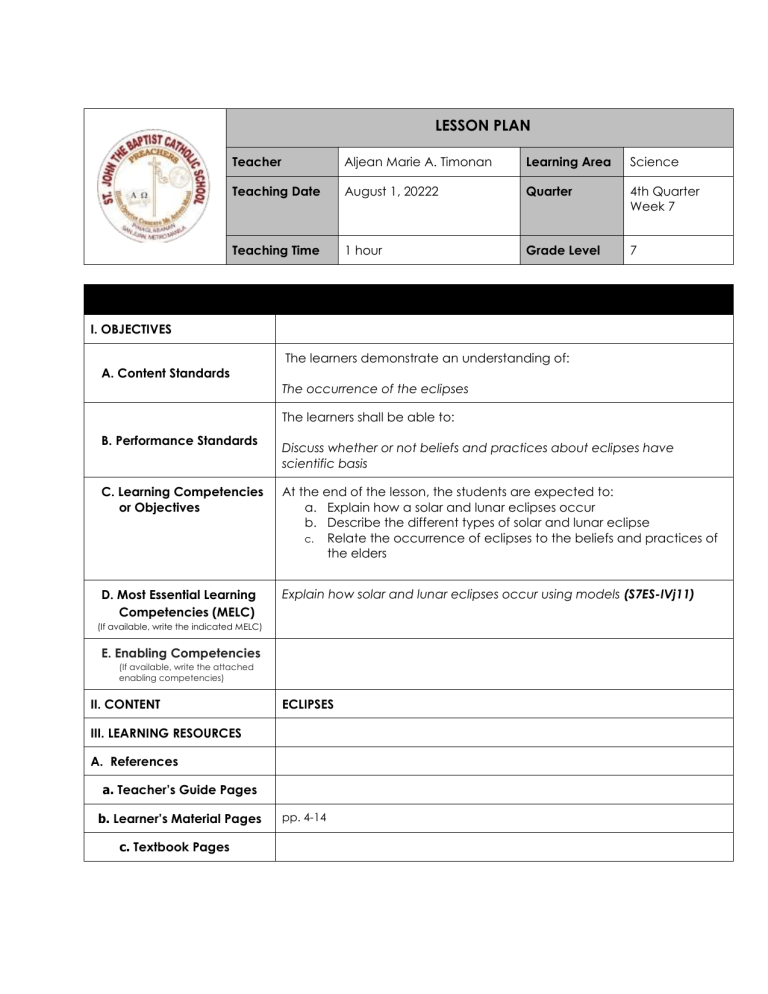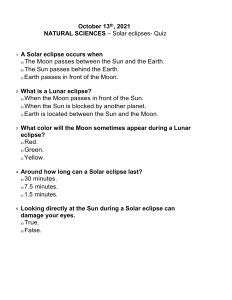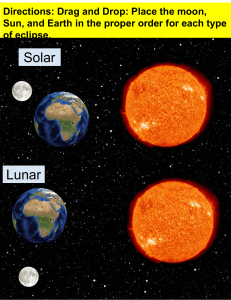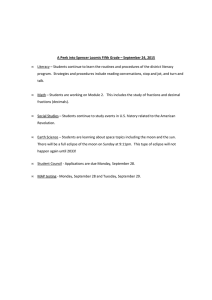
LESSON PLAN Teacher Aljean Marie A. Timonan Learning Area Science Teaching Date August 1, 20222 Quarter 4th Quarter Week 7 Teaching Time 1 hour Grade Level 7 I. OBJECTIVES The learners demonstrate an understanding of: A. Content Standards The occurrence of the eclipses The learners shall be able to: B. Performance Standards Discuss whether or not beliefs and practices about eclipses have scientific basis C. Learning Competencies or Objectives At the end of the lesson, the students are expected to: a. Explain how a solar and lunar eclipses occur b. Describe the different types of solar and lunar eclipse c. Relate the occurrence of eclipses to the beliefs and practices of the elders D. Most Essential Learning Competencies (MELC) Explain how solar and lunar eclipses occur using models (S7ES-IVj11) (If available, write the indicated MELC) E. Enabling Competencies (If available, write the attached enabling competencies) II. CONTENT ECLIPSES III. LEARNING RESOURCES A. References a. Teacher’s Guide Pages b. Learner’s Material Pages c. Textbook Pages pp. 4-14 d. Additional Materials from Learning Resources B. List of Learning Resources for Development and Engagement Activities Youtube links: https://youtu.be/Jejjy-LitcM https://youtu.be/LH-aSizsx1o https://youtu.be/WI8aFiB8nsY https://youtu.be/VMdFG54IcXg IV. PROCEDURES Daily Routinary Activities (Synchronous) ● Greetings ● Online prayer ● Checking of attendance ● Online class etiquette V. TEACHING STRATEGY A. Reviewing previous lesson or presenting the new lesson Expository Method Steps in Expository Method ● Approach ● Presentation ● Application Task 1: Looking Back ● The teacher will present a Powerpoint slide showing a diagram of seasons. The students will identify what solstice or equinox occurs in each position. Retrieved from: https://o.quizlet.com/aQaZp5yPdWBmA1IKsNS-UQ_b.png Answer key: A. Summer Solstice B. Autumnal Equinox C. Winter Solstice D. Vernal Equinox B. Establishing a purpose for the lesson Task 2: Focus on Me! (Motivation) ● The teacher will present a picture of the formation of a shadow and the students will observe what the picture is all about. The teacher will ask the students about their observations. ● The teacher will introduce the topic by relating the formation of shadows to the occurrence of an eclipse. Retrieved from: http://www.daviddarling.info/images3/shadow_formation.jpg Task 3: Guess the word (Unlocking of vocabulary words) ● 1. 2. 3. 4. 5. The students will guess the word being defined by arranging the jumbled letters. L P S E C I E - a natural phenomenon that occurs when a celestial body passes through the shadow of another celestial object M R U B A - the dark inner portion of the shadow cone E M P U R N A B - the lighter outer portion of the shadow cone U M N A T R B A- the part of the moon’s shadow that extends beyond the umbra Y S G Y Z Y - is an alignment of three celestial objects such as the sun, moon and earth in a gravitational system Answers: 1. 2. 3. 4. 5. C. Presenting examples/instances of the new lesson Eclipse Umbra Penumbra Antumbra Syzygy Solar and Lunar Eclipse in the Philippines (Contextualization/Localization) ● The teacher will present an audio-visual presentation of eclipses that recently occurred in the Philippines. Partial solar eclipse nasaksihan sa Pilipinas | TV Patrol Espesyal na Lunar Eclipse ngayong gabi, sumabay sa Super Moon | Saksi Guide questions: 1. What type of eclipse is shown in the videos? 2. What is the other term/ name for total lunar eclipse? 3. Have you witnessed an eclipse before? D. Discussing new concepts and practicing new skills #1 APPROACH ● The teacher will ask the students to share how seasons occur. Once the students have shared their answers, the teacher will present a diagram showing the interplay between the sun, earth, and moon. Retrieved from: https://cdn.vectorstock.com/i/1000x1000/72/85/earth-changingseason-vector-32707285.webp ● ● The teacher will explain that as the earth travels around the sun and different hemispheres receive uneven distribution of sunlight because of its tilted axis, there is another celestial body that moves around the earth which is the moon. The teacher will introduce that as the earth, moon, and sun aligned, an eclipse will occur. To further understand the different types of eclipse, the teacher will discuss it using PowerPoint with illustrations. PRESENTATION ● The teacher will present a PowerPoint to discuss how a solar and lunar eclipse occur using illustrations. After discussion, the students will answer an activity. Task 4: Fill me out Directions: Study the illustration and complete the paragraph by filling in the blank with an appropriate word from the box below. Word bank Lunar Solar Full Moon New Moon Umbra Moon Sun Retrieved from: https://cdn.kastatic.org/ka-perseusimages/d04abccf3d445d66acf585ca1a71b4e643d2e512.png A (1)__________ eclipse happens when the Moon passes between the Sun and the Earth and casts a shadow on Earth’s surface. Solar eclipse only happens during a (2) __________. The (3) __________ blocks the light of the sun from reaching earth. This causes an eclipse of the (4) __________. The (5) __________ is the darkest inner portion of the shadow, while penumbra is the lighter outer portion. Answer key: 1. Solar 2. New moon 3. Moon 4. Sun 5. Umbra Task 5: Fill me out Directions: Study the illustration and complete the paragraph by filling in the blank with an appropriate word from the box below. Word bank Lunar Solar Earth Full Moon Umbra Penumbra Retrieved from: https://cdn.wccftech.com/wpcontent/uploads/2017/02/eclipse.png When the Earth comes between the Sun and Moon, a (1) __________ eclipse occurs. During a lunar eclipse, the (2) __________ shadow falls on the surface of the moon. The moon is at its (3) __________ phase during a lunar eclipse. Total lunar eclipse occurs when the moon passes into the (4) __________ of earth’s shadow. When the moon passes into the (5) __________, a penumbral lunar eclipse happens. Answer key: 1. 2. 3. 4. 5. E. Discussing new concepts and practicing new skills #2 Lunar Earth Full moon Umbra Penumbra PRESENTATION ● The teacher will present PowerPoint slides describing the different types of solar and lunar eclipse. ● The students will answer an activity called “Guess the Eclipse”. The teacher will provide descriptions for each picture to help students identify the correct answer. Task 6: Guess the Eclipse Directions: Determine what eclipse is shown. Choose the answer from the box below. 1. Image source: https://c.tadst.com/gfx/1200x630/total-solar-eclipse.jpg?1 Description: the moon completely blocks the entire disk of the sun. 2. 3. 4. Image source: https://www.esa.int/Science_Exploration/Human_and_Robotic_Ex ploration/Exploration/Total_lunar_eclipse_2019 Description: the moon falls or passes into the darkest portion of the earth’s shadow (Umbra) Image source: https://mb.com.ph/wpcontent/uploads/2020/11/LUNAR12.jpg Description: the moon passes into the faint shadow of the earth (Penumbra) which is why it is difficult to distinguish Image source: https://c.tadst.com/gfx/600x337/eclipsetraditions.jpg?1 Description: only a portion of the sun is blocked by the moon 5. Image source: https://upload.wikimedia.org/wikipedia/commons/f/f3/Annular_S olar_Eclipse_in_Jaffna_-_26_December_2019_%282%29.jpg Description: the moon appears to be smaller than the sun which creates an outer ring of light from the sun WORD BANK Partial solar eclipse Annular solar eclipse Total lunar eclipse Total solar eclipse Penumbral lunar eclipse Partial lunar eclipse Answer key: 1. Total solar eclipse 2. Total lunar eclipse 3. Penumbral lunar eclipse 4. Partial solar eclipse 5. Annular solar eclipse F. Developing mastery (leads to formative assessment 3) 3-2-1 technique ● The teacher will ask the students to write 3 things they learned, 2 things they found interesting, and 1 question they still have in mind. ● The students will write their answer on a discussion board called “padlet”. ● The teacher will share the whole discussion board with the class Link for padlet: https://padlet.com/timonanama/u40u3xbt5cgi2dvd G. Finding practical applications of concepts and skills in daily living APPLICATION Task 6: Believe it or not! ● The teacher will show a list of situations where the students need to agree or disagree ● The situation is based on the beliefs and practices associated with the occurrence of eclipse. ● The student needs to react using a thumbs up or thumbs down reaction. ● The teacher will explain that some of these situations don't have any scientific basis Situations: 1. There are only up to 5 partial, annular, or total solar eclipses per year 2. A celestial snake swallows the sun or moon during an eclipse causing it to disappear 3. The heaven’s is giving mankind a sign of an upcoming global scale of misfortune manifested by the darkening of the surface of the sun or moon 4. Total solar eclipses produce harmful rays that can cause blindness. H. Making generalizations and abstractions about the lesson I. Evaluating learning ● The teacher will ask the students what they have learned in the lesson. The teacher will randomly call students to answer. Task 7: Multiple choice quiz (Google forms) ● The student will answer a 10-item quiz via Google form. Directions: Choose the letter of the correct answer. 1. Which type of eclipse does the following statement describe? When the moon travels between the Sun and the Earth, blocking the Sun's light from the Earth in the middle of the day. A. Annular Solar Eclipse B. Lunar Eclipse C. Solar Eclipse D. Total Lunar Eclipse 2. Which type of eclipse does the following statement describe? The moon passes completely into the earth’s umbral shadow causing the moon to appear reddish in color. A. Lunar Eclipse B. Solar Eclipse C. Total Lunar Eclipse D. Total Solar Eclipse 3. Which type of eclipse occurs when the Sun and the Moon are exactly in line, but the size of the Moon appears to be smaller than the Sun? A. Annular Solar eclipse B. Hybrid Eclipse C. Partial Solar Eclipse D. Total Solar eclipse 4. How does a solar eclipse happen? A. When the shadows of the Earth and Moon are cast in space. B. When the Moon comes directly between the Sun and the Earth. C. When the shadows of the Moon and Earth are neither too high nor too low. D. When the Sun is on the opposite side of the Earth and the Moon. 5. How does a lunar eclipse happen? A. When the Sun is in between the Earth and the Moon B. When the Moon casts a shadow on the surface of the Earth C. When the Earth casts a shadow on the surface of the Moon D. When the moon comes in between the Sun and the Earth 6. What type of solar eclipse occurs when only a portion of the Sun is blocked by the Moon? A. Annular B. Hybrid C. Partial D. Total 7. Which of the following is the correct line up when there is a lunar eclipse? A. Sun – Earth – Moon B. Earth – Sun – Moon C. Moon – Sun – Earth D. Sun – Moon – Earth 8. Which of the following is the correct line up when there is a solar eclipse? A. Sun – Earth – Moon B. Earth – Sun – Moon C. Moon – Sun – Earth D. Sun – Moon – Earth 9. During an eclipse, pregnant women should stay indoors to avoid their unborn child developing a deformity. Is this true or false? A. True B. False 10. Looking directly at the Sun during a Solar eclipse can damage your eyes or even cause blindness. Is this true or false? A. True B. False Answers key: 1. C 2. C 3. A 4. B 5. C 6. 7. 8. 9. 10. J. Additional Activities for Application or Remediation (EXTEND) C A D B A Assignment: Paint me an Eclipse! Directions: On the box below, draw the two types of eclipses: Solar and Lunar, with their corresponding labels. (Note: You may also color your drawings) Solar Eclipse Lunar Eclipse Rubrics for Solar and Lunar Eclipse Drawing V. REMARKS Criteria Points Achievement of objectives 10 Creativity 5 Neatness 5 Total: 20 points VI. REFLECTION No.of learners who earned 80% on the formative assessment No.of learners who require additional activities for remediation Did the remedial lessons work? No.of learnerswho have caught up with the lesson No.of learners who continue to require remediation Which of my teaching strategies worked well ? Why did these work? What difficulties did I encounter which my principal or supervisor can help me solve? What innovation or localized materials did I use/discover which I wish to share with other teachers? Prepared by: Aljean Marie A. Timonan Reviewed by: Checked by:




